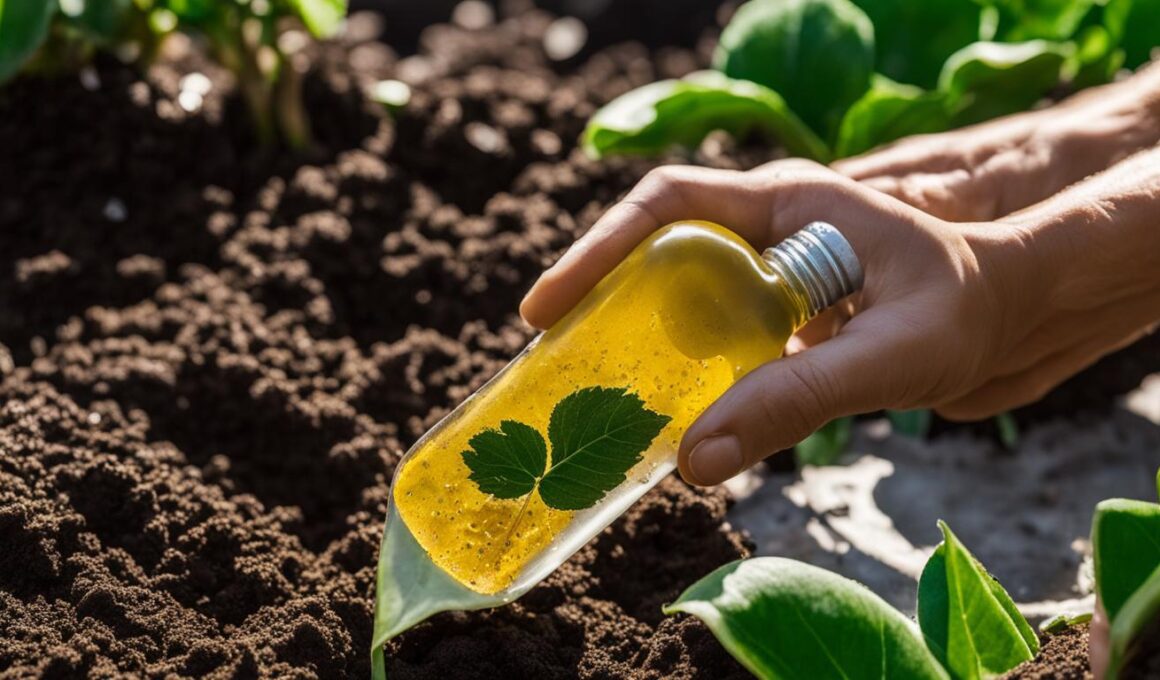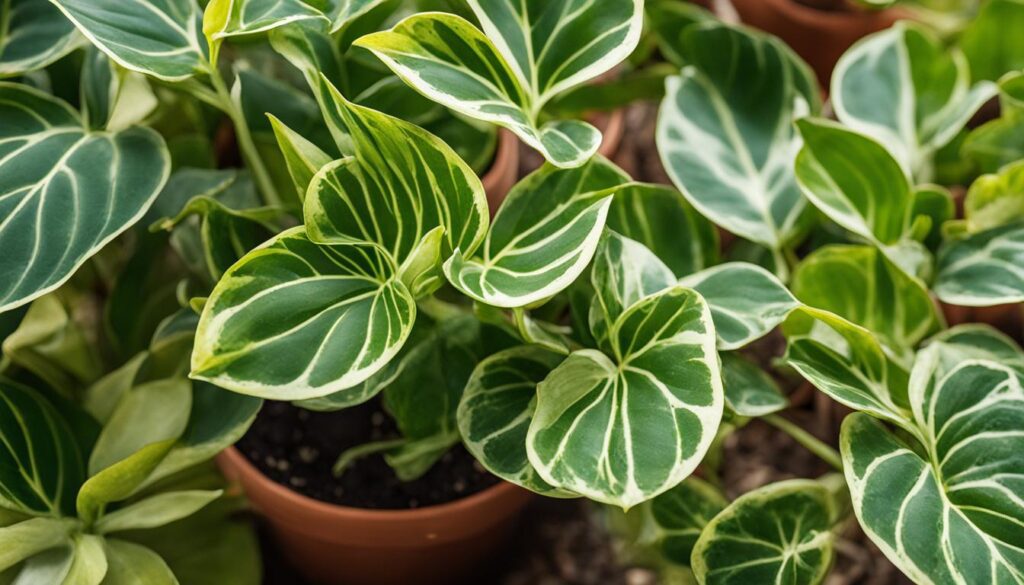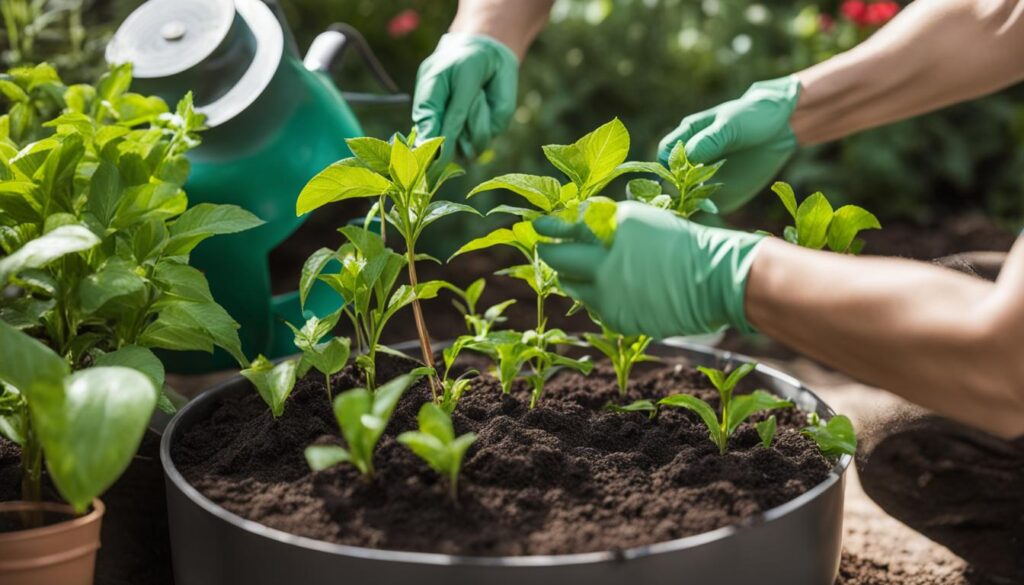Molybdenum is an essential minor element that plays a crucial role in the normal growth and health of plants. While it is needed in small quantities compared to other major elements, molybdenum deficiencies can have detrimental effects on plant growth. If left untreated, these deficiencies can lead to stunted growth and symptoms similar to nitrogen deficiency.
This article will provide you with effective strategies and preventative measures for treating molybdenum deficiency in plants. By understanding the symptoms, functions, and soil conditions associated with molybdenum deficiency, you can take the necessary steps to ensure the optimal health and growth of your plants.
Post Summary
- Molybdenum is an essential element for plant growth and health.
- Molybdenum deficiency can lead to stunted growth and symptoms similar to nitrogen deficiency.
- Understanding the symptoms and functions of molybdenum deficiency is crucial for effective treatment.
- Soil pH plays a significant role in molybdenum availability.
- Treating molybdenum deficiency involves strategies such as liming and applying molybdenum fertilizers.
Understanding Molybdenum Deficiency in Plants
Molybdenum deficiency in plants can have significant impacts on their overall health and growth. Recognizing the symptoms and understanding the functions of molybdenum in plants are essential for effective treatment. Symptoms of molybdenum deficiency include stunted growth, pale or yellowish green leaves, and leaf tissue damage. These visual cues can indicate that a plant lacks the necessary molybdenum levels to support its metabolic processes.
Molybdenum plays a crucial role in nitrogen metabolism within plants. It is a critical component of enzymes that convert nitrate into ammonia, a form that can be used by plants for growth and development. Without sufficient molybdenum, plants are unable to properly metabolize nitrogen and may experience imbalances in nutrient uptake. This can result in the accumulation of nitrate in the leaves, leading to growth issues and further nutrient deficiencies.
Understanding the symptoms and functions of molybdenum in plants is vital for diagnosing and treating deficiencies. By identifying these issues early on, gardeners and growers can take the necessary steps to correct molybdenum deficiencies and promote healthy plant growth.
Recognizing Molybdenum Deficiency Symptoms
“Molybdenum deficiency in plants is characterized by symptoms such as stunted growth, pale or yellowish green leaves, and leaf tissue damage.”
Molybdenum deficiency symptoms in plants should not be confused with other nutrient deficiencies. It’s important to consider the specific symptoms related to molybdenum and compare them to other potential issues. In some cases, molybdenum deficiency symptoms may closely resemble nitrogen deficiency symptoms. However, understanding the unique characteristics of molybdenum deficiency will help differentiate it from other nutrient deficiencies.
- Stunted growth
- Pale or yellowish green leaves
- Leaf tissue damage
Observing these symptoms in plants, particularly those grown in acid soils, is a strong indication of a potential molybdenum deficiency. Proper diagnosis and treatment can help restore healthy molybdenum levels and ensure optimal plant growth.
Functions of Molybdenum in Plants
“Molybdenum is necessary for the proper function of enzymes involved in nitrogen metabolism.”
Molybdenum’s primary function in plants is to aid in the conversion of nitrate into ammonia. This conversion process is crucial for plants to utilize nitrogen effectively for growth and development. The enzymes that facilitate this conversion require molybdenum as a cofactor to carry out their metabolic functions. Without sufficient molybdenum, these enzymes are unable to operate properly, leading to imbalances in nitrogen metabolism.
By understanding the key functions of molybdenum in plants, growers can recognize the importance of maintaining adequate molybdenum levels. Ensuring plants have access to sufficient molybdenum will support their ability to metabolize nitrogen and promote healthy growth.
Soil Conditions and Molybdenum Deficiency
The availability of molybdenum in soil is greatly influenced by soil pH. Molybdenum deficiencies in plants are more commonly observed in acidic soils. Acidic soils tend to bind molybdenum, making it less available for plants. Soils with a pH of 5.5 or lower are more prone to molybdenum deficiency. However, deficiencies have also been reported in some cases where the soil pH is above 6.0. Therefore, soil conditions play a vital role in the occurrence of molybdenum deficiency in plants.
To ensure optimal molybdenum availability for plants, it is essential to monitor soil pH levels and make necessary amendments. Increasing soil pH through liming can help release bound molybdenum, making it more accessible for plant uptake. By maintaining a soil pH within the optimal range, you can reduce the risk of molybdenum deficiency in your plants.
Soil pH and Molybdenum Availability
| Soil pH | Molybdenum Availability |
|---|---|
| Below 5.5 | Low |
| 5.5 – 6.0 | Moderate |
| Above 6.0 | High |
As shown in the table above, maintaining a soil pH above 6.0 ensures higher molybdenum availability. However, it is important to note that other factors, such as organic matter content, nutrient interactions, and soil texture, can also influence molybdenum availability. Regular soil testing and analysis can provide valuable insights into the specific soil conditions and molybdenum requirements for your plants.
“The availability of molybdenum in soil is greatly influenced by soil pH. Acidic soils with a pH below 5.5 tend to bind molybdenum, making it less available for plants.”
By understanding the relationship between soil pH and molybdenum availability, you can take appropriate measures to prevent and treat molybdenum deficiency in your plants. Ensuring a suitable pH range and implementing proper soil management practices contribute to the overall health and vitality of your plants.
Molybdenum Deficiency in Different Regions
Molybdenum deficiencies in plants are prevalent in various regions, including coastal areas and irrigation areas in New South Wales (NSW). These regions have reported cases of molybdenum deficiency, impacting plant health and growth. Coastal areas are known for their acidic soils, which bind molybdenum and make it less available for plants. This, coupled with the high rainfall in these regions, further exacerbates molybdenum deficiencies.
In NSW’s irrigation areas, molybdenum deficiency is also a concern. The continuous use of irrigation water can leach molybdenum from the soil, leading to deficiencies in crops. It is essential for farmers in these areas to be aware of and address molybdenum deficiencies to ensure optimal plant growth and yield.
Molybdenum Deficiency in Different Regions of NSW
| Region | Prevalence of Molybdenum Deficiency |
|---|---|
| Coastal Areas | High |
| Central Tablelands | Moderate |
| Northern Tablelands | Moderate |
| Murrumbidgee Irrigation Areas | Moderate |
| Southern Tablelands | High |
Understanding the geographical distribution of molybdenum deficiencies aids in identifying regions where treatment and prevention are necessary. By addressing molybdenum deficiencies in plants, farmers can promote healthy plant growth and enhance agricultural productivity in these regions.
Diagnosing Molybdenum Deficiency in Plants
Diagnosing molybdenum deficiency in plants can be challenging but is crucial for effective treatment. Symptoms such as stunting, chlorosis, and tissue damage can indicate molybdenum deficiency, but specific tests are needed for accurate diagnosis. Tissue testing and experimental applications of molybdenum solutions can help determine if a plant or crop is suffering from molybdenum deficiency. Various factors and tests can aid in diagnosing molybdenum deficiency in plants.
Visual Symptoms: Molybdenum deficiency in plants is characterized by stunted growth, pale or yellowish green leaves, and leaf tissue damage. These symptoms can often be mistaken for other nutrient deficiencies or environmental factors. It is essential to consider the overall health of the plant and observe any patterns or changes in growth.
Quote: “Early diagnosis of molybdenum deficiency is key to implementing timely treatment and preventing further damage to plants. Conducting visual inspections, combined with laboratory tests, can provide accurate results and guide appropriate actions.” – Dr. Botanist, Plant Nutrition Expert
Laboratory Testing: Tissue testing involves collecting samples from the affected plant parts and analyzing them for molybdenum levels. This method provides quantitative data on the nutrient content and helps determine if the plant is deficient. Experimental applications of molybdenum solutions, such as foliar sprays or soil drenches, can also be used to confirm deficiency symptoms and assess the plant’s responsiveness to molybdenum supplementation.
Other Tests: In addition to laboratory testing, soil pH testing can provide valuable insights into molybdenum availability. Acidic soils with a pH of 5.5 or less are more prone to molybdenum deficiencies. Conducting a comprehensive soil analysis can help identify potential deficiencies and guide appropriate corrective measures.
Common Molybdenum Deficiency Tests
| Test | Description |
|---|---|
| Tissue Testing | Collecting plant tissue samples for laboratory analysis to determine molybdenum levels and confirm deficiency. |
| Experimental Applications | Applying molybdenum solutions to affected plants to observe their responsiveness and assess deficiency symptoms. |
| Soil pH Testing | Measuring the acidity of the soil to identify potential molybdenum deficiencies, as acidic soils are more prone to molybdenum deficiencies. |
Accurate diagnosis of molybdenum deficiency in plants is crucial for implementing the most appropriate treatment strategies. Visual symptoms, laboratory testing, and soil analysis are valuable tools for identifying and confirming deficiencies. By understanding the diagnostic methods available, plant owners and growers can take proactive measures to address molybdenum deficiencies and promote optimal plant health and growth.
Treating Molybdenum Deficiency in Plants
Correcting molybdenum deficiency in plants requires implementing various strategies and practices. One effective method is liming the soil to increase molybdenum availability. By raising the soil pH, liming helps release molybdenum, making it more accessible to plants over time. However, it’s important to note that liming may take longer to produce noticeable results, so patience is key when using this approach.
Applying molybdenum fertilizers is another way to address deficiency symptoms more quickly. These fertilizers can be mixed with other fertilizers or applied as a solution. The choice of molybdenum compound and the recommended application rates may vary depending on the specific crop and its requirements. Consulting with a local agronomist or agricultural expert can provide valuable insights on the most suitable molybdenum fertilizer for your plants.
Furthermore, it is crucial to consider the existing soil conditions and pH levels to ensure the effectiveness of molybdenum treatment. Regular soil testing can provide essential information about the nutrient levels and pH of the soil, enabling growers to make informed decisions about molybdenum application and dosage.
| Treatment Method | Description |
|---|---|
| Liming | Increasing soil pH to enhance molybdenum availability over time. |
| Molybdenum Fertilizers | Applying molybdenum compounds mixed with fertilizers or as a solution for quicker correction. |
| Soil Testing | Regularly testing soil pH and nutrient levels to inform treatment decisions. |
By adopting these treatment methods and considering factors such as soil conditions and pH levels, you can effectively correct molybdenum deficiency in your plants. Remember that proper treatment is essential not only for resolving deficiencies but also for ensuring the overall health and growth of your plants.
Molybdenum and Livestock
Molybdenum fertilizers can have implications for livestock, particularly in terms of copper and molybdenum interactions. Excessive molybdenum can induce copper deficiency in animals, as molybdenum combines with copper in the rumen. This can lead to reduced copper absorption and utilization, affecting the normal functioning of various enzymes and metabolic processes. Copper deficiency in livestock can result in reduced growth rates, anemia, skeletal abnormalities, and compromised immune function.
To prevent molybdenum-induced copper deficiency, it is crucial to ensure a balanced diet for livestock. This includes providing adequate levels of copper through supplementation or selecting feeds with higher copper content. It is important to regularly monitor the copper and molybdenum levels in the diet and adjust accordingly to maintain optimal livestock health. Consulting with a veterinarian or animal nutritionist can help determine the appropriate copper supplementation and management practices.
Excessive molybdenum can induce copper deficiency in animals, as molybdenum combines with copper in the rumen.
When using molybdenum fertilizers on grazing lands, it is essential to consider the potential impact on livestock. Controlling molybdenum levels in the soil and plants can help minimize the risk of copper deficiency in grazing stock. Regular soil testing can provide insights into the molybdenum content and help make informed decisions regarding fertilizer application rates and management practices. Additionally, rotating grazing areas and providing access to a variety of forage can help reduce the concentration of molybdenum and minimize the negative effects on livestock.
Proper management and control of molybdenum levels are necessary to ensure the health of both plants and grazing stock. By understanding the interactions between molybdenum and copper and implementing appropriate strategies, livestock owners can safeguard the well-being and productivity of their animals.
Different Forms of Molybdenum Compounds
Different forms of molybdenum compounds are available for treating molybdenum deficiency in plants. It is important to choose the right form based on your specific application method and crop requirements. Here are three common forms of molybdenum compounds:
- Molybdenum Trioxide: This form is suitable for molybdenized superphosphate but not recommended for sprays in growing crops. Molybdenum trioxide is often used in slow-release fertilizers that provide a long-term solution to molybdenum deficiency.
- Sodium Molybdate: Sodium molybdate is a water-soluble form of molybdenum commonly used for soil or foliar application. It dissolves easily in water, making it convenient for application through irrigation systems or as a spray.
- Ammonium Molybdate: Similar to sodium molybdate, ammonium molybdate is also water-soluble and suitable for soil or foliar application. It is often used in liquid fertilizers or as a soil amendment to correct molybdenum deficiencies.
When choosing a molybdenum compound, consider the compatibility with your application method and the availability of the compound in your region. Additionally, consult with agricultural experts or conduct soil tests to determine the most appropriate form of molybdenum compound for your specific situation.
| Molybdenum Compound | Application Method | Recommended Crops |
|---|---|---|
| Molybdenum Trioxide | Molybdenized superphosphate | Crops requiring long-term molybdenum availability |
| Sodium Molybdate | Soil or foliar application, water-soluble | Various crops, suitable for most application methods |
| Ammonium Molybdate | Soil or foliar application, water-soluble | Various crops, suitable for most application methods |
By understanding the different forms of molybdenum compounds and their specific applications, you can choose the most effective and efficient solution for treating molybdenum deficiency in your plants.
Conclusion
Treating molybdenum deficiency in plants is crucial for maintaining plant health and promoting optimal growth. By addressing the specific needs of your plants, you can ensure they receive the necessary molybdenum levels for their development. Understanding the symptoms and functions of molybdenum deficiency is key to properly diagnosing and treating the issue.
Soil conditions play a significant role in molybdenum availability, with deficiencies more common in acidic soils. Monitoring your soil pH and taking appropriate measures, such as liming, can help increase molybdenum availability in the long term.
In addition, applying molybdenum fertilizers, either mixed with other fertilizers or as a solution, can provide a quicker correction of molybdenum deficiency symptoms. However, it is important to consider the implications for livestock, especially in terms of copper and molybdenum interactions. Proper management and control of molybdenum levels are necessary to ensure the health of both plants and grazing stock.
By following these recommended strategies and preventative measures, you can effectively address molybdenum deficiencies and ensure healthy and thriving plants. Remember, a well-nourished plant is more resistant to diseases and environmental stressors, leading to improved overall plant health and growth.
Can Molybdenum Deficiency in Plants Cause Yellowing Leaves?
If your zz plant yellow leaves troubleshooting has led you to suspect molybdenum deficiency, you may notice the leaves turning yellow. Molybdenum is essential for nitrogen metabolism in plants, and a lack of it can lead to chlorosis and overall poor plant growth.
FAQ
What are the symptoms of molybdenum deficiency in plants?
Symptoms of molybdenum deficiency in plants include stunted growth, pale or yellowish green leaves, and leaf tissue damage.
What causes molybdenum deficiency in plants?
Molybdenum deficiencies in plants mainly occur on acid soils with a pH of 5.5 or less. Soil pH influences molybdenum availability, with acidic soils binding molybdenum and making it unavailable for plants.
Where are molybdenum deficiencies in plants prevalent?
Molybdenum deficiencies in plants have been reported in various regions, including the coastal areas and Southern Tablelands of New South Wales. The Central Tablelands, Northern Tablelands, and Murrumbidgee irrigation areas have also experienced molybdenum deficiency cases.
How can molybdenum deficiency in plants be diagnosed?
Diagnosing molybdenum deficiency in plants can be challenging but can be done through tissue testing and experimental applications of molybdenum solutions.
How can molybdenum deficiency in plants be treated?
Molybdenum deficiency in plants can be treated by liming the soil to increase pH and release molybdenum, as well as by applying molybdenum fertilizers either mixed with fertilizers or as a solution.
How does molybdenum affect livestock?
Excessive molybdenum can induce copper deficiency in livestock, as molybdenum combines with copper in the rumen. Proper management and control of molybdenum levels are necessary to ensure the health of both plants and grazing stock.
What are the different forms of molybdenum compounds?
Different forms of molybdenum compounds used for treating molybdenum deficiency in plants include molybdenum trioxide, sodium molybdate, and ammonium molybdate. The choice of compound depends on the method of application and the specific requirements of the crops.











